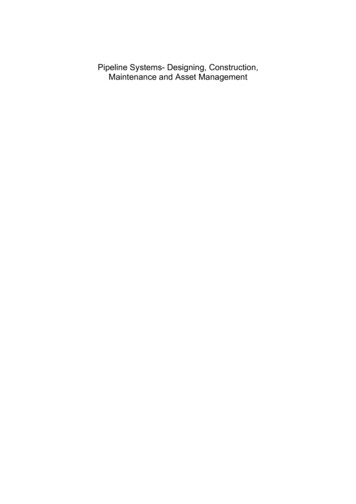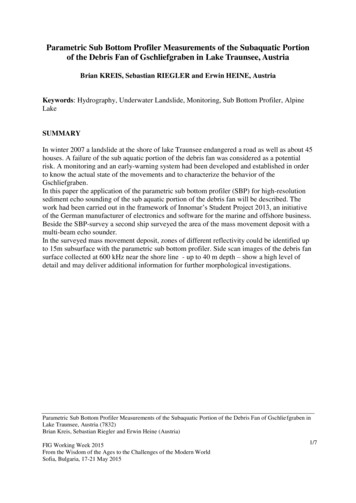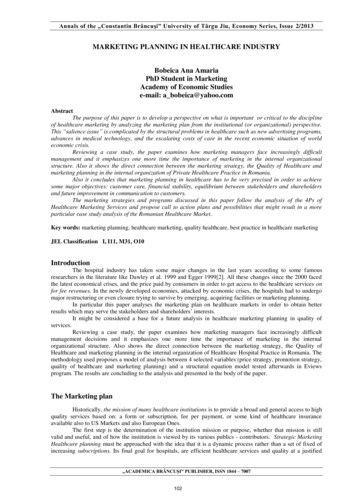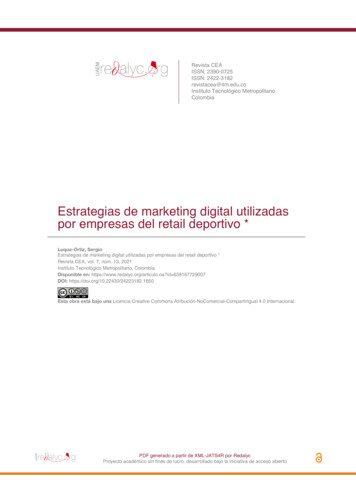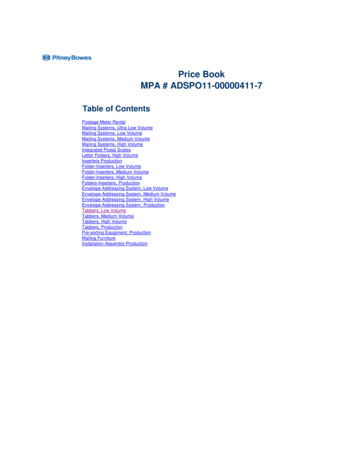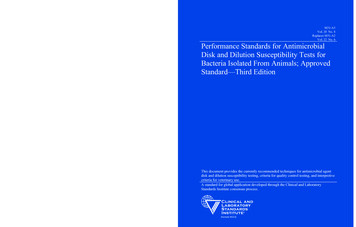
Transcription
This is a preview of "M31-A3". Click here to purchase the full version from the ANSI store.M31-A3Vol. 28 No. 8Replaces M31-A2Vol. 22 No. 6Performance Standards for AntimicrobialDisk and Dilution Susceptibility Tests forBacteria Isolated From Animals; ApprovedStandard—Third Edition940 West Valley Road Suite 1400 Wayne, PA 19087 USA PHONE 610.688.0100FAX 610.688.0700 E-MAIL: customerservice@clsi.org WEBSITE: www.clsi.org ISBN 1-56238-659-X(Formerly NCCLS)This document provides the currently recommended techniques for antimicrobial agentdisk and dilution susceptibility testing, criteria for quality control testing, and interpretivecriteria for veterinary use.A standard for global application developed through the Clinical and LaboratoryStandards Institute consensus process.(Formerly NCCLS)
This is a preview of "M31-A3". Click here to purchase the full version from the ANSI store.Clinical and Laboratory Standards InstituteAdvancing Quality in Health Care TestingThe Clinical and Laboratory Standards Institute (CLSI)(formerly NCCLS) is an international, interdisciplinary,nonprofit, standards-developing, and educationalorganization that promotes the development and use ofvoluntary consensus standards and guidelines within thehealth care community. It is recognized worldwide forthe application of its unique consensus process in thedevelopment of standards and guidelines for patienttesting and related health care issues. Our process isbased on the principle that consensus is an effective andcost-effective way to improve patient testing and healthcare services.In addition to developing and promoting the use ofvoluntary consensus standards and guidelines, weprovide an open and unbiased forum to address criticalissues affecting the quality of patient testing and healthcare.PUBLICATIONSA document is published as a standard, guideline, orcommittee report.Standard A document developed through the consensusprocess that clearly identifies specific, essentialrequirements for materials, methods, or practices for usein an unmodified form. A standard may, in addition,contain discretionary elements, which are clearlyidentified.Guideline A document developed through the consensusprocess describing criteria for a general operatingpractice, procedure, or material for voluntary use. Aguideline may be used as written or modified by the userto fit specific needs.Most documents are subject to two levels of consensus—“proposed” and “approved.” Depending on the need forfield evaluation or data collection, documents may also bemade available for review at an intermediate consensuslevel.Proposed A consensus document undergoes the first stageof review by the health care community as a proposedstandard or guideline. The document should receive a wideand thorough technical review, including an overall reviewof its scope, approach, and utility, and a line-by-line reviewof its technical and editorial content.Approved An approved standard or guideline has achievedconsensus within the health care community. It should bereviewed to assess the utility of the final document, toensure attainment of consensus (ie, that comments on earlierversions have been satisfactorily addressed), and to identifythe need for additional consensus documents.Our standards and guidelines represent a consensus opinionon good practices and reflect the substantial agreement bymaterially affected, competent, and interested partiesobtained by following CLSI’s established consensusprocedures. Provisions in CLSI standards and guidelinesmay be more or less stringent than applicable regulations.Consequently, conformance to this voluntary consensusdocument does not relieve the user of responsibility forcompliance with applicable regulations.COMMENTSThe CLSI voluntary consensus process is a protocolestablishing formal criteria for:The comments of users are essential to the consensusprocess. Anyone may submit a comment, and all commentsare addressed, according to the consensus process, by thecommittee that wrote the document. All comments,including those that result in a change to the document whenpublished at the next consensus level and those that do notresult in a change, are responded to by the committee in anappendix to the document. Readers are strongly encouragedto comment in any form and at any time on any document.Address comments to the Clinical and Laboratory StandardsInstitute, 940 West Valley Road, Suite 1400, Wayne, PA19087, USA. the authorization of a projectVOLUNTEER PARTICIPATION the development and open review of documents the revision of documents in response to commentsby users the acceptance of a document as a consensusstandard or guideline.Health care professionals in all specialties are urged tovolunteer for participation in CLSI projects. Please contactus at customerservice@clsi.org or 610.688.0100 foradditional information on committee participation.Report A document that has not been subjected toconsensus review and is released by the Board ofDirectors.CONSENSUS PROCESS
This is a preview of "M31-A3". Click here to purchase the full version from the ANSI store.Volume 28 Number 8M31-A3ISBN 1-56238-659-XISSN 0273-3099Performance Standards for Antimicrobial Disk and DilutionSusceptibility Tests for Bacteria Isolated From Animals; ApprovedStandard—Third EditionJeffrey L. Watts, PhD, RM(AAM)Thomas R. Shryock, PhDMichael Apley, DVM, PhDDonald J. BadeSteven D. Brown, PhDJeffrey T. Gray, PhDHenry Heine, PhDRob P. Hunter, MS, PhDDik J. Mevius, DVM, PhDMark G. Papich, DVM, MSPeter Silley, PhDGary E. Zurenko, MSAbstractIf the susceptibility of a bacterial pathogen to antimicrobial agents cannot be predicted based on the identity of the organismalone, in vitro antimicrobial susceptibility testing of the organism isolated from the disease processes in animals is indicated.Susceptibility testing is particularly necessary in those situations where the etiologic agent belongs to a bacterial species forwhich resistance to commonly used antimicrobial agents has been documented, or could arise.A variety of laboratory techniques can be used to measure the in vitro susceptibility of bacteria to antimicrobial agents. Clinicaland Laboratory Standards Institute document M31-A3—Performance Standards for Antimicrobial Disk and DilutionSusceptibility Tests for Bacteria Isolated From Animals; Approved Standard—Third Edition describes the standard agar diskdiffusion method, as well as standard broth dilution (macrodilution and microdilution) and agar dilution techniques. It alsoincludes a series of procedures designed to standardize test performance. The performance, applications, and limitations of thecurrent CLSI-recommended methods are described.The tabular information in this document presents the most current information for drug selection, interpretation, and qualitycontrol. In an increasing number of compounds where veterinary-specific interpretive criteria are not available, humaninterpretive criteria are used. As more veterinary-specific information becomes available, these changes will be incorporated intofuture revisions of this document.Clinical and Laboratory Standards Institute (CLSI). Performance Standards for Antimicrobial Disk and Dilution SusceptibilityTests for Bacteria Isolated From Animals; Approved Standard—Third Edition. CLSI document M31-A3 (ISBN 1-56238-659-X).Clinical and Laboratory Standards Institute, 940 West Valley Road, Suite 1400, Wayne, Pennsylvania 19087-1898 USA, 2008.The Clinical and Laboratory Standards Institute consensus process, which is the mechanism for moving a document through two or more levelsof review by the health care community, is an ongoing process. Users should expect revised editions of any given document. Because rapidchanges in technology may affect the procedures, methods, and protocols in a standard or guideline, users should replace outdated editionswith the current editions of CLSI/NCCLS documents. Current editions are listed in the CLSI catalog and posted on our website atwww.clsi.org. If your organization is not a member and would like to become one, and to request a copy of the catalog, contact us at:Telephone: 610.688.0100; Fax: 610.688.0700; E-Mail: customerservice@clsi.org; Website: www.clsi.org(Formerly NCCLS)
This is a preview of "M31-A3". Click here to purchase the full version from the ANSI store.Number 8M31-A3Copyright 2008 Clinical and Laboratory Standards Institute. Except as stated below, neither thispublication nor any portion thereof may be adapted, copied, or otherwise reproduced, by any means(electronic, mechanical, photocopying, recording, or otherwise) without prior written permission fromClinical and Laboratory Standards Institute (“CLSI”).CLSI hereby grants permission to each individual member or purchaser to make a single reproduction ofthis publication for use in its laboratory procedure manual at a single site. To request permission to usethis publication in any other manner, contact the Executive Vice President, Clinical and LaboratoryStandards Institute, 940 West Valley Road, Suite 1400, Wayne, Pennsylvania 19087-1898, USA.Suggested Citation(CLSI. Performance Standards for Antimicrobial Disk and Dilution Susceptibility Tests for BacteriaIsolated From Animals; Approved Standard—Third Edition. CLSI document M31-A3. Wayne, PA:Clinical and Laboratory Standards Institute; 2008.)Tentative StandardAugust 1997Approved StandardJune 1999Approved Standard—Second EditionMay 2002Approved Standard—Third EditionFebruary 2008ISBN 1-56238-659-XISSN 0273-3099ii
This is a preview of "M31-A3". Click here to purchase the full version from the ANSI store.Volume 28M31-A3Committee MembershipArea Committee on MicrobiologyMary Jane Ferraro, PhD, MPHChairholderMassachusetts General HospitalBoston, MassachusettsMichael L. Wilson, MDDenver Health Medical CenterDenver, ColoradoMichael A. Pfaller, MDUniversity of Iowa College ofMedicineIowa City, IowaAdvisorsJohn H. Rex, MD, FACPVice-ChairholderAstraZenecaCheshire, United KingdomBarbara Ann Body, PhD, D(ABMM)LabCorpBurlington, North CarolinaBetty (Betz) A. Forbes, PhD,D(ABMM)Medical College of Virginia CampusRichmond, VirginiaNancy L. Anderson, MMSc,MT(ASCP)Centers for Disease Control andPreventionAtlanta, GeorgiaEllen Jo Baron, PhDStanford Hospital and ClinicsPalo Alto, CaliforniaDonald R. Callihan, PhDBD Diagnostic SystemsSparks, MarylandRobert P. Rennie, PhDUniversity of Alberta HospitalEdmonton, Alberta, CanadaThomas R. Shryock, PhDElanco Animal HealthGreenfield, IndianaJana M. Swenson, MMScCenters for Disease Control andPreventionAtlanta, GeorgiaMelvin P. Weinstein, MDRobert Wood Johnson MedicalSchoolNew Brunswick, New JerseyFreddie Mae PooleFDA Center for Devices andRadiological HealthRockville, MarylandLynne S. Garcia, MSLSG & AssociatesSanta Monica, CaliforniaDaniel F. Sahm, PhDEurofins MedinetHerndon, VirginiaRichard L. Hodinka, PhDChildren’s Hospital of PhiladelphiaPhiladelphia, PennsylvaniaMatthew A. Wikler, MD, MBA,FIDSAPacific Beach BioSciences, Inc.San Diego, CaliforniaFred C. Tenover, PhD, ABMMCenters for Disease Control andPreventionAtlanta, GeorgiaJames H. Jorgensen, PhDUniversity of Texas Health ScienceCenterSan Antonio, TexasGail L. Woods, MDCentral Arkansas VeteransHealthcareLittle Rock, ArkansasJohn D. Turnidge, MDWomen’s and Children’s HospitalNorth Adelaide, AustraliaSubcommittee on Veterinary Antimicrobial Susceptibility TestingJeffrey L. Watts, PhD, RM(AAM)ChairholderPfizer Animal HealthRichmond, MichiganMike Apley, DVM, PhDKansas State UniversityManhattan, KansasHenry Heine, PhDUSAMRIIDFt. Detrick, MarylandGary E. Zurenko, MSMicromyx, LLCKalamazoo, MichiganRob P. Hunter, MS, PhDElanco Animal HealthGreenfield, IndianaAdvisorsDonald J. BadeMicrobial Research, Inc.Fort Collins, ColoradoDik J. Mevius, DVM, PhDCentral Institute for Animal DiseaseControl-CIDC-LelystadLelystad, NetherlandsSteven D. Brown, PhDThe Clinical Microbiology InstituteWilsonville, OregonMark G. Papich, DVM, MSNorth Carolina State UniversityRaleigh, North CarolinaJeffrey T. Gray, PhDDes Moines UniversityDes Moines, IowaPeter Silley, PhDMB Consult LimitedLymington, Hampshire,United KingdomJo Abraham, DVM, MSBayer Health Care LLCShawnee Mission, KansasMelanie R. Berson, DVMFDA Center for VeterinaryMedicineRockville, MarylandDiane M. Citron, M(ASCP)R.M. Alden Research LaboratorySanta Monica, Californiaiii
This is a preview of "M31-A3". Click here to purchase the full version from the ANSI store.Number 8Advisors (Continued)Ronald N. Jones, MDJMI LaboratoriesNorth Liberty, IowaCindy LindemanPfizer Animal HealthKalamazoo, MichiganJennifer LorbachTrek Diagnostic Systems, Inc.Cleveland, OhioCarol W. Maddox, PhDUniversity of IllinoisUrbana, IllinoisMarilyn N. Martinez, PhDFDA Center for VeterinaryMedicineRockville, MarylandPatrick McDermott, PhDFDA Center for VeterinaryMedicineLaurel, MarylandivM31-A3Stefan Schwarz, PhDInstitut Für Tierzucht (FAL)Neustadt-Mariensee, GermanyThomas R. Shryock, PhDElanco Animal HealthGreenfield, IndianaClyde Thornsberry, PhDEurofins MedinetFranklin, TennesseeJohn D. Turnidge, MDWomen’s and Children’s HospitalNorth Adelaide, AustraliaRobert D. Walker, PhDGlade Park, ColoradoChing Ching Wu, DVM, PhDPurdue University School ofVeterinary MedicineWest Lafayette, IndianaS. Steve Yan, PhDFDA Center for VeterinaryMedicineRockville, MarylandStaffClinical and Laboratory StandardsInstituteWayne, PennsylvaniaLois M. Schmidt, DAVice President, StandardsDevelopment and MarketingTracy A. Dooley, BS, MLT(ASCP)Staff LiaisonMelissa A. LewisEditor
This is a preview of "M31-A3". Click here to purchase the full version from the ANSI store.Volume 28M31-A3ContentsAbstract .iCommittee Membership. iiiForeword .ix1Scope . 12Introduction . 13Definitions . 24Indications for Performing Susceptibility Testing . 54.15Selection of Antimicrobial Agents. 65.15.25.35.45.55.66Source . 25Weighing Antimicrobial Agent Powders . 25Preparing Stock Solutions . 27Number of Concentrations Tested . 27Agar Dilution Procedure . 279.19.210Indications for Performing Broth and Agar Dilution Susceptibility Tests . 25Antimicrobial Agents . 258.18.28.38.49Equivalent MIC Breakpoints . 13Methodologies . 13Streptococcus spp. . 19Pasteurella multocida and Mannheimia haemolytica . 20Other Organisms . 20Campylobacter jejuni and Related Species. 20Anaerobic Organisms . 21Detection of Resistant Staphylococci . 21Detection of Resistant Enterococci . 23Broth and Agar Dilution Susceptibility Testing . 247.18Nonproprietary Names . 7Selection Guidelines . 7Antimicrobial Classes . 7Guidelines for Routine Reporting . 11Guidelines for Selective Reporting . 11Interpretive Categories . 12Disk Diffusion Susceptibility Tests . 136.16.26.36.46.56.66.76.86.97Limitations of Disk Diffusion and Dilution Methods . 5Reagents and Materials . 28Agar Dilution Testing of C. jejuni . 31Broth Dilution Procedure . 3210.110.210.3Broth Medium . 32Cation Adjustments. 32Preparing and Storing Diluted Antimicrobial Agents . 33v
This is a preview of "M31-A3". Click here to purchase the full version from the ANSI store.Number 8M31-A3Contents (Continued)10.410.510.610.711Broth Dilution Susceptibility Testing of Fastidious Organisms . 3511.111.211.311.411.512Purpose . 39QC Responsibilities . 40Suggested Reference Strains . 41Disk Diffusion Tests . 43Frequency of QC Testing (also refer to Appendix B) . 43Dilution Susceptibility Tests . 45Daily Testing. 46Weekly Testing . 46Corrective Action . 46Specific Antimicrobial Resistance Tests. 4815.115.215.315.416Penicillin-Ampicillin Resistance . 39Vancomycin Resistance . 39High-Level Aminoglycoside Resistance. 39QC Guidelines. n/Oxacillin Resistance . 37Oxacillin Screening Plates . 38Reduced Susceptibility to Vancomycin . 38Detection of Resistant Enterococci . 3913.113.213.314P. multocida and M. haemolytica . 35Broth Microdilution Testing of H. somni and A. pleuropneumoniae . 35Broth Microdilution Testing of Campylobacter spp. . 36Streptococci and Listeria spp. . 36Staphylococcus hyicus . 37Detection of Resistant Staphylococci . 3712.112.212.313Standardizing Inoculum for Broth Dilution Testing . 34Inoculating Broth . 34Incubation . 35Interpreting Results . 35Purpose . 48β-Lactamase Tests . 48Selecting a β-Lactamase Test . 48Detection of Extended-Spectrum, β-Lactamase-Producing Enterobacteriaceae . 48Cumulative Antimicrobial Susceptibility Profile . 49References . 50Appendix A. Antimicrobial Susceptibility QC Record. 52Appendix B1. Disk Diffusion Daily QC Testing Protocol . 53Appendix B2. Disk Diffusion Weekly QC Testing Protocol . 54Appendix C1. Aerobic Dilution Daily QC Testing Protocol . 55Appendix C2. Aerobic Dilution Weekly QC Testing Protocol. 56vi
This is a preview of "M31-A3". Click here to purchase the full version from the ANSI store.Volume 28M31-A3Contents (Continued)Appendix D1. Disk Diffusion QC Troubleshooting Guide . 57Appendix D2. MIC QC Troubleshooting Guide . 60Table 1. Antimicrobial Agents That Could Be Considered for Routine Testing by VeterinaryMicrobiology Laboratories . 63Table 2. Zone Diameter Interpretive Standards and Minimal Inhibitory Concentration (MIC)Breakpoints for Veterinary Pathogens . 65Table 3. Culture Collection Numbers for Organisms Used for QC of Antimicrobial SusceptibilityTests . 73Table 4. Acceptable QC Ranges of Antimicrobial Disk Susceptibility Test Zone Diameters (mm)for Reference Strains on Mueller-Hinton Agar (Except Where Noted). 74Table 5. Acceptable QC Ranges of MICs for Broth Microdilution (µg/mL) for Reference Strains. 76Table 5A. Acceptable QC Ranges of MICs (μg/mL) for the Agar Dilution Method of TestingCampylobacter jejuni ATCC 33560 . 78Table 5B. Proposed QC Ranges of MICs (μg/mL) for the Broth Microdilution SusceptibilityMethod of Testing Campylobacter jejuni ATCC 33560. 79Table 5C. Proposed QC Ranges of MICs (µg/mL) for Anaerobic Reference Strains Using AgarDilution . 80Table 5D. Proposed QC Ranges of MICs (µg/mL) for Anaerobic Reference Strains Using BrothMicrodilution . 81Table 6. Acceptable QC Ranges for Histophilus somni and Actinobacillus pleuropneumoniae . 82Table 7. Standard Methods for Susceptibility Testing of Some Fastidious and Special ProblemVeterinary Pathogens . 83Table 8. Solvents and Diluents for Preparation of Stock Solutions of Antimicrobial AgentsRequiring Solvents Other Than Water . 84Table 9A. Screening and Confirmatory Tests for Extended-Spectrum β-lactamases (ESBLs) inKlebsiella pneumoniae, K. oxytoca, Escherichia coli, and Proteus mirabilis (Zone Diameter) . 85Table 9B. Screening and Confirmatory Tests for ESBLs in Klebsiella pneumoniae, K. oxytoca,Escherichia coli, and Proteus mirabilis (MIC) . 86Table 9C. Screening Tests for Oxacillin Resistance and Reduced Susceptibility to Vancomycin inStaphylococcus aureus . 87Table 9D. Disk Diffusion Test for Prediction of mecA-Mediated Resistance in Staphylococci . 88Table 9E. Disk Diffusion Screening Tests for High-Level Aminoglycoside Resistance (HLAR) . 89vii
This is a preview of "M31-A3". Click here to purchase the full version from the ANSI store.Number 8M31-A3Contents (Continued)Table 9F. MIC Screening Tests for High-Level Aminoglycoside Resistance (HLAR) andVancomycin Resistance in Enterococcus spp. . 90Glossary 1. Antimicrobial Class, Antimicrobial Subclass Designation, Antimicrobial Agents, andAntimicrobial Resistance Mechanisms . 91Glossary 2. Abbreviations for Antimicrobial Agents Incorporated Into Disks or SusceptibilityPanels . 94Summary of Comments and Subcommittee Responses . 96The Quality Management System Approach . 98Related CLSI Reference Materials . 99viii
This is a preview of "M31-A3". Click here to purchase the full version from the ANSI store.Volume 28M31-A3ForewordThis revision of the M31 standard represents a continuation of the collective efforts of the Subcommitteeon Veterinary Antimicrobial Susceptibility Testing (VAST) to produce a globally useful consensusdocument for standardized in vitro susceptibility testing of veterinary pathogens. The subcommittee hasworked diligently to improve M31-A2—Performance Standards for Antimicrobial Disk and DilutionSusceptibility Tests for Bacteria Isolated from Animals; Approved Standard—Second Edition primarilyby incorporating relevant updates derived from CLSI documents M2 and M7,1,2 as well as referencingother relevant CLSI documents. The subcommittee recognizes the ongoing CLSI efforts that arenecessary to maintain CLSI documents M2 and M71,2 as “state of the art,” and expresses its appreciationto the Subcommittee on Antimicrobial Susceptibility Testing for its contributions. In addition, it is alsoappropriate to acknowledge the users of M31-A2 for their continued support and application of thestandard in their daily work routine. The user community is encouraged to demonstrate responsibleapplication of the CLSI methods when publishing work in peer-reviewed journals.Global events and perceptions regarding the use of antimicrobial agents in animals have placed even moreimportance on the essential r
alone, in vitro antimicrobial susceptibility testing of the organism isolated from the disease processes in animals is indicated. . Performance Standards for Antimicrobial Disk and Dilution Susceptibility Tests for Bacteria Isolated From Animals; Approved Standard—Third Edition. CLSI document M31-A3 (ISBN 1-56238-659-X).

